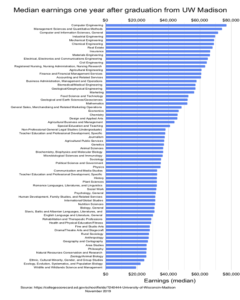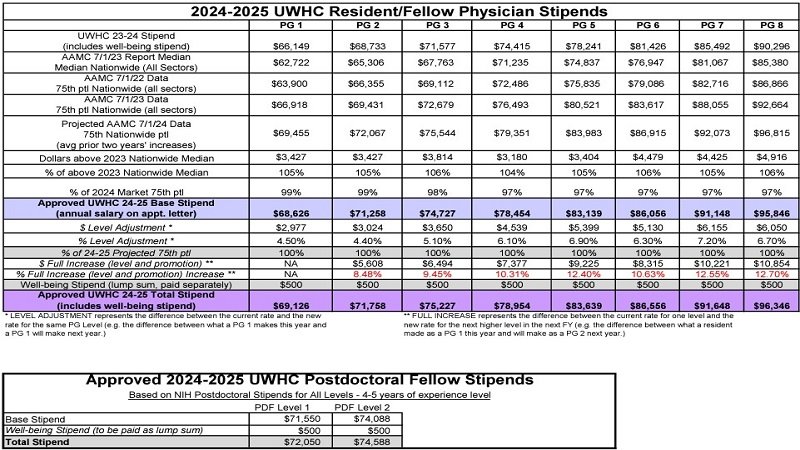Understanding “uw madison salaries”: A Comprehensive Guide
The University of Wisconsin-Madison (UW Madison) is one of the most prestigious public universities in the United States, known for its cutting-edge research, top-tier faculty, and high-impact contributions to various academic fields. Salaries at UW Madison, like any other institution of higher learning, reflect a wide range of factors including position, experience, and the specific role within the university. This article will delve into “uw madison salaries” by examining the pay structure, factors influencing these salaries, and their broader implications.
Here’s a structured biography table format for clarity:
| Category | Details |
|---|---|
| Full Name | University of Wisconsin-Madison (UW Madison) |
| Type | Public Research University |
| Location | Madison, Wisconsin, USA |
| Founded | 1848 |
| Chancellor | Jennifer L. Mnookin |
| Campus Size | 936 acres |
| Number of Students | 47,000+ (as of 2024) |
| Number of Employees | Approximately 24,000 |
| Main Areas of Study | Science, Engineering, Medicine, Law, Business, Humanities, Social Sciences |
| Research Funding | Over $1 billion annually |
| Ranking | Consistently ranked in the top 50 global universities |
| Significant Alumni | John Bardeen, Frank Lloyd Wright, Charles Lindbergh, Dick Cheney, Joan Cusack |
| Notable Achievements | Discovery of Vitamin A, invention of the isolation of human embryonic stem cells |
| Mission Statement | To improve people’s lives through education, research, and service |
| Motto | “Nummen Lumen” (God, our light) |
This table offers a concise, high-level biography of UW Madison, covering its history, impact, and key details.
Introduction: The Importance of Understanding UW Madison Salaries
As an academic powerhouse, UW Madison employs thousands of individuals, from professors and researchers to administrative staff and support personnel. Understanding the salary structure at UW Madison is crucial for prospective employees, current staff, and even students interested in how public funds and tuition dollars are allocated.
“uw madison salaries” not only give insights into the compensation structure for higher education but also reflect broader trends in public university funding, faculty recruitment, and retention. This comprehensive article will explore the factors influencing salaries, the impact of different roles within the university, and trends in compensation over recent years.
Early Insights: Factors Influencing UW Madison Salaries
1. Position and Role
The most significant factor influencing “uw madison salaries” is the specific role or position an individual holds. Salaries vary drastically depending on whether the individual is a tenured professor, a non-tenured lecturer, administrative personnel, or a research assistant. Below are some key insights:
- Faculty Salaries: Professors and faculty members often receive the highest salaries due to their extensive education, experience, and research contributions. A tenured professor at UW Madison typically earns a significantly higher salary compared to non-tenured positions.
- Non-Faculty Staff: Administrative and support roles, including administrative assistants, IT professionals, and student service coordinators, have varied salary structures depending on their responsibilities and qualifications.
- Graduate Assistants and Researchers: These positions often come with lower salaries, as they are considered part-time or temporary roles. However, many of these positions include stipends, tuition waivers, and other non-monetary benefits that make the overall compensation package appealing.
2. Academic Department
Another key factor influencing “uw madison salaries” is the specific academic department or division where an individual works. For example, salaries for professors in the School of Medicine or the College of Engineering tend to be higher than those in the humanities or social sciences. This difference is largely due to market demand for highly specialized fields, where universities must compete with private sector offers to attract top talent.
- STEM vs. Humanities: Salaries in STEM (Science, Technology, Engineering, and Mathematics) departments at UW Madison tend to be higher because of external market pressures. Faculty members in these areas often have more lucrative opportunities outside academia, which forces the university to offer competitive salaries.
- Professional Schools: Professors in the Law School or School of Business often command higher salaries due to the prestige and profitability of these programs. These schools also bring in significant revenue through tuition, alumni donations, and external partnerships, allowing them to offer more competitive salaries.
3. Experience and Tenure
Experience and tenure status play a critical role in determining UW Madison salaries. Tenured professors, who have secured permanent positions due to their contributions to academia, typically earn higher salaries than their non-tenured counterparts. Additionally, faculty with decades of teaching and research experience will command higher salaries than those who are relatively new to the field.
- Tenured Faculty: Earning tenure at UW Madison is a significant milestone that comes with both job security and a substantial salary increase. Tenure is awarded to those who have made notable contributions in research, teaching, and service to the university.
- Non-Tenured Faculty: Lecturers and adjunct professors often earn considerably less than tenured faculty. These positions may be part-time or based on short-term contracts, offering less stability and lower pay.
4. Research Grants and External Funding
A unique aspect of UW Madison salaries, particularly for research faculty, is the role of external funding. Professors and researchers who secure grants from federal agencies (such as the National Institutes of Health or the National Science Foundation) or private foundations often see a significant boost in their overall compensation. These funds can be used to support salary enhancements, research projects, and additional staffing.
- Research Incentives: Faculty members who bring in large grants may also receive bonuses or additional compensation as part of incentive programs that reward research productivity and innovation.
5. Location and Cost of Living
Although Madison, Wisconsin, is not one of the most expensive cities in the United States, the cost of living does have an impact on salaries. The university must offer competitive wages that reflect the local housing market, transportation costs, and other living expenses.
- Madison’s Affordability: Compared to larger cities like New York or San Francisco, Madison offers a relatively affordable cost of living, which can make the salaries at UW Madison more attractive when viewed in this context. Many employees find that their salaries go further due to lower housing costs and the availability of local amenities.
Salary Structure at UW Madison
1. Faculty Salaries: A Breakdown by Rank
UW Madison faculty salaries vary significantly depending on the rank of the professor. Here’s a detailed breakdown:
- Full Professors: At the top of the academic hierarchy, full professors at UW Madison can earn upwards of $150,000 annually, with some in high-demand fields like engineering or business earning even more. Full professors have typically been at the university for several years and have a substantial body of published research and teaching experience.
- Associate Professors: Associate professors, who are typically in the middle of their academic careers, earn salaries ranging from $80,000 to $120,000. These faculty members have often earned tenure and are continuing to build their research portfolios.
- Assistant Professors: Assistant professors are at the beginning of their careers and earn salaries ranging from $60,000 to $90,000. These positions are typically non-tenured but are on the path to tenure review.
- Adjunct and Part-Time Faculty: Adjunct faculty members are often paid per course or on a part-time basis. Their salaries can range from $3,000 to $10,000 per course, depending on the subject matter and department.
2. Administrative and Staff Salaries
Salaries for non-academic staff at UW Madison vary based on the department and the complexity of the job. Here’s a general breakdown:
- University Administration: High-ranking administrators, such as deans, provosts, and chancellors, often earn salaries in the range of $200,000 to $500,000 annually. These positions require a significant amount of responsibility, as they oversee large departments and are responsible for the university’s strategic direction.
- Mid-Level Administrative Roles: Positions like department chairs, program directors, and office managers typically earn between $50,000 and $100,000, depending on the department and their responsibilities.
- Support Staff: Administrative assistants, secretaries, and IT support staff earn salaries that range from $35,000 to $60,000, depending on their experience and role within the university.
3. Research and Graduate Assistant Salaries
- Graduate Teaching Assistants (TAs): Graduate TAs are typically compensated with stipends, tuition waivers, and healthcare benefits. The average stipend for a TA at UW Madison ranges from $15,000 to $25,000 annually, depending on the department.
- Research Assistants (RAs): Research assistants, particularly in the sciences, are often funded through research grants and may receive stipends similar to those of TAs. Their compensation packages also include tuition remission and healthcare coverage.
The Role of Public Funding and Budget Allocations in UW Madison Salaries
As a public university, UW Madison relies heavily on state funding, tuition, and research grants to fund salaries and other operational expenses. The state of Wisconsin allocates a portion of its budget to public higher education institutions, including UW Madison. In recent years, however, budget cuts have placed pressure on the university’s salary structure.
- State Funding: Declining state funding has been a challenge for UW Madison, which has had to find alternative revenue sources to maintain competitive salaries for faculty and staff. This includes increasing tuition, seeking private donations, and securing more research grants.
- Tuition Revenue: Tuition revenue plays a critical role in determining UW Madison salaries, especially for non-research staff. As tuition increases, so does the ability of the university to offer competitive salaries to its employees.

Trends in UW Madison Salaries Over the Years
1. Salary Growth and Inflation
Over the past decade, salaries at UW Madison have generally increased in response to inflation and the rising cost of living. However, salary growth has been uneven across different sectors of the university. Faculty in high-demand areas such as engineering, business, and medicine have seen larger increases compared to those in the humanities or social sciences.
2. Gender Pay Gap
Like many other institutions, UW Madison has faced scrutiny over the gender pay gap. Studies have shown that female faculty members, on average, earn less than their male counterparts, even when controlling for factors such as experience and department. The university has made efforts to address this disparity by implementing salary equity reviews and adjusting pay scales where necessary.
3. Faculty Retention and Recruitment
One of the biggest challenges UW Madison faces in terms of salaries is retaining top talent. Faculty members, particularly those in STEM fields, are often lured away by private sector opportunities that offer significantly higher pay. To counteract this, the university has developed retention packages that include salary increases, research funding, and other incentives.
Conclusion: The Bigger Picture of UW Madison Salaries
“uw madison salaries” are a reflection of the university’s mission to balance academic excellence with financial sustainability. Salaries at the institution are influenced by a variety of factors, including position, department, experience, and external funding. While salaries at UW Madison are generally competitive within the public university system, the institution faces ongoing challenges such as state budget cuts, faculty retention, and salary equity.
For prospective employees and students alike, understanding the salary structure at UW Madison provides valuable insights into the financial dynamics of one of the nation’s leading research universities. Whether you are considering a career in academia or simply curious about how public universities allocate their resources, UW Madison salaries offer a fascinating glimpse into the economics of higher education. See More


